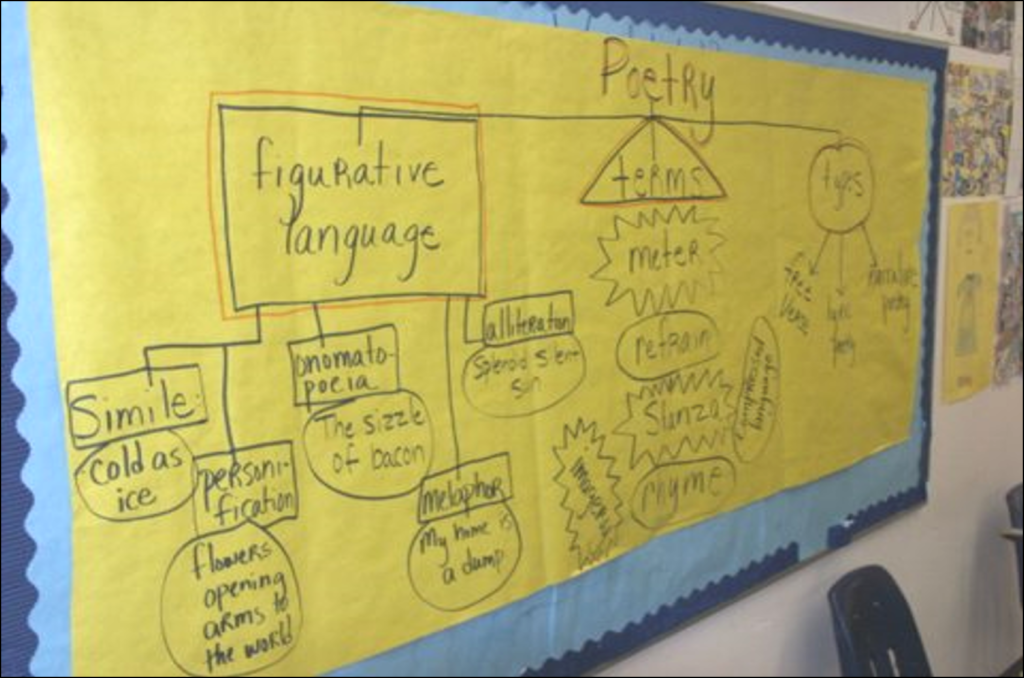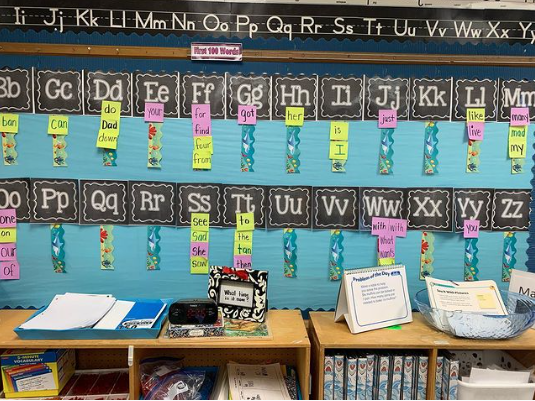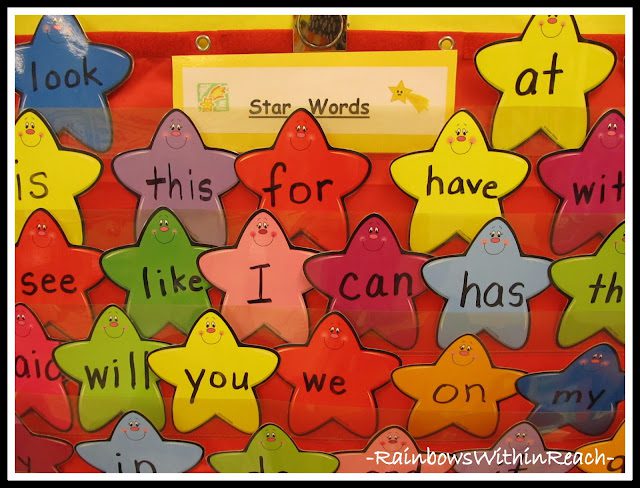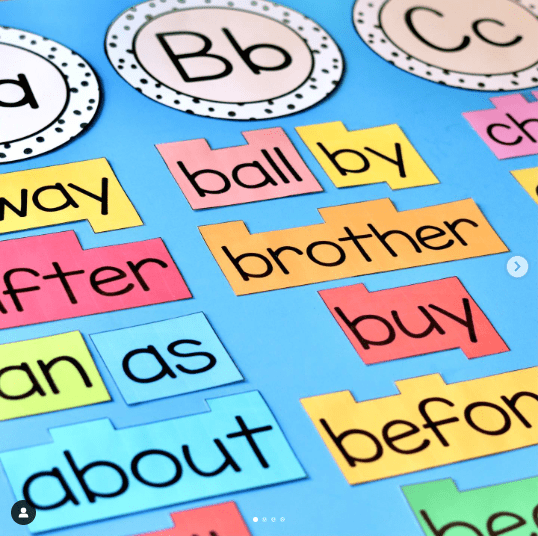What is a Word Wall?
Word Walls are organized collections of words placed on a wall or other surface in the classroom. They are excellent tools for building word consciousness in students through increased vocabulary interaction and social learning opportunities; especially as students make connections among important concepts and big ideas. Interactive Word Walls, vocabulary notebooks, and periodic reviews are all important ways to revisit and reinforce vocabulary over time.
What does a Word Wall look like?
There are several different types of Word Walls which serve different purposes and focus on different skills. For example, it is common for primary classrooms to display high-frequency Word Walls, but it is unlikely to find such a Word Wall in a secondary classroom.
Word Walls in classrooms take on many forms. They can be color-coded by content area on index cards that are affixed to the wall. They can be on chart paper, a display board, or a concept map. No matter the way you choose to display Word Walls, the words on the Word Wall must be large enough that they can easily be seen by all students in the room from wherever they are seated.
Regardless of the structure, all grade levels should have content area Word Walls on display.
How are Word Walls organized?
How many Word Walls are in a room may depend on how the content areas are organized, whether high-frequency words or retired Word Walls are utilized, or how many courses are taught by a single teacher. For example:
- Elementary classrooms may have one Word Wall for various content areas, color-coded for each subject. Additionally, there may be a high-frequency Word Wall.
- In secondary classrooms, there may be separate Word Walls for each course, as well as specialized Word Walls, such as testing words.
How to Use a Word Wall in the Classroom?
Word Walls can be effective learning tools, or they can be wallpaper. Even the most organized Word Walls won’t help students learn words unless they are used. The words displayed on the Word Wall should be words that you currently want your students to use and should come down and get replaced by new words when a new lesson or unit is introduced. The same is true for high-frequency Word Walls.
Use the words on the Word Wall to create Advance Organizers (i.e. Student Learning Maps and Concept Maps) to meaningfully distinguish and highlight important vocabulary concepts (keywords), characteristics (descriptions or examples), and categories (“chunks” of learning connected to Learning Goals).
How do I retire words from the wall?

Once students are using the words appropriately, the words can come down. When words come down from the high frequency or content Word Walls, they can go to a retired Word Wall elsewhere in the room, or in an interactive vocabulary notebook. Students should use the interactive vocabulary notebooks daily for new word learning and can use them for structured review, writing, word games, and retired words. They are especially useful when learning word parts.

How do I use Word Walls during remote learning?
Virtual Word Walls apply the same characteristics as physical ones. They are most impactful when students know where to find the tool and are expected to use it for a purpose (i.e. writing, review, or as a scaffold for an assignment). Word wall ideas for remote learning are:
- Create a dedicated location in your classroom (or classroom website) to display vocabulary from the current lesson and unit.
- The size and color of fonts and virtual backgrounds are chosen to enhance visibility, not create “visual noise” that detracts from students’ ability to locate and see displayed words.
- Avoid busy patterns and small and light-colored fonts (i.e. yellow) to maximize displayed vocabulary.
- Use a digital “Word Wall” explicitly during a lesson as a scaffold for the assignment and to promote wordplay during Learning Activities.
- Provide a consistent and easily accessible “virtual” location to display current vocabulary that is used by both the teacher and students in lesson instruction.
More Word Wall Ideas for Virtual Classrooms
- Create a Concept as an editable (or fillable) PDF.
- Try Google Jamboards, Milanote, Miro, or MindMup to virtually create and manipulate concept maps and other word clusters.
- Dedicate a space on the main home page of your Google Classroom (or another LMS platform). Create a separate page for words as they are archived.
- Flip your Word Wall activity to create a super-effective previewing strategy! Create an Advance Organizer for a unit (i.e. Student Learning Map) or a lesson (i.e. Concept Map) and use it to activate students’ thinking prior to the start of a lesson.
- Use virtual games for wordplay to provide students with multiple opportunities to interact with the words, and as periodic review to improve students’ storage and retrieval of word meanings.
Interactive Word Wall Activities and Games
Primary: LINGO
- Ask students to vote for words prior to the game. Digital Adaptation: Try dotstorming for easy card voting.
- Provide students with a blank LINGO grid (may be a downloadable form or sent home as a part of a packet).
- Students will practice writing each word anywhere they choose on the grid.
- Shuffle index cards with the words and call the words one at a time.
- Have students chant the spelling of each word and then cover it with an object. (Try Lima Beans as students may not be too tempted to eat them!).
- The first student to have a complete row covered wins LINGO.
- Students can clear their sheets and play again.
Intermediate: Scrabble Scramble
- Digital Adaptation: Use Google Jamboards to create whiteboard spaces for your students.
- Each whiteboard should have digital “Post-It” notes for each letter of the alphabet. Some letters may need to be duplicated.
- On the first whiteboard, show students a scrambled up word from the concept map or one of your vocabulary clusters.
- Give the definition of the word or create a story passage about the word.
- Students take turns unscrambling the words, that is, moving the letters until they correctly form the word.
- Check students’ thinking by viewing everyone’s Google Jamboard by viewing the expanded frame at the top.
- Unscramble your word on the first whiteboard to show students the correct answer.
Secondary: Possible Sentences
- Give students a word bank of words to choose from, and ask them to use some of the words to create possible sentences, predicting what will be learned that day.
- The teacher displays and discusses the meanings of six new words critical to the lesson.
- persecution / famine / scarcity / prosperity / migration / exodus
- The teacher adds four related words that are familiar to most students to the above list.
- homelands / agriculture / survival / poverty
- Students work in collaborative pairs to look for words that are connected and create sentences before reading the text.
- Digital Adaptation: Try it with Padlet. The board can be organized as columns to cluster words and provide a place for the students to post their Possible Sentences.
Want more ideas on how to redesign your current vocabulary activities and strategies for your physical and virtual Word Walls? Join us for our upcoming Effective Vocabulary Instruction Training of Trainers Virtual Institute. Contact us today for a quote.
Looking for word wall ideas? Word walls are a popular teaching strategy to improve literacy skills across the curriculum. Basically, word walls are a collection of important words displayed in large, visible letters on any display surface in the classroom. Your word wall should be an interactive tool for students and contain an array of words that can be used during writing and reading.
A traditional word wall is organized alphabetically using all 26 letters of the alphabet. Sight words (also known as high-frequency words or no-excuse words) are placed under each letter based on the first letter of each word. An alternative option is a sound wall, which is based on the science of reading. This strategy organizes words by their speech sounds (phonemes) rather than alphabetically.
But word walls need not be limited to just sight words. You can use them for spelling words, content area words, unit vocabulary words, parts of speech, and much more. The possibilities are endless!
Here we’ve gathered 24 of our favorite word wall ideas to help you get started. And for more ideas from classroom teachers, check out Teaching Made Practical and Mrs. Beattie’s Classroom.
1. Traditional Word Wall
This kindergarten word wall follows the traditional model. Each letter of the alphabet is prominently displayed with vocabulary words written on colored cards underneath them.
Source: Cozy Classroom Crew
2. Star Words
Early learners need to master basic, frequently used words in order to progress as readers. This word wall includes “star words” for students to refer to at any time.
Source: Rainbows Within Reach
3. Polka Dot Word Wall
Colored cards on this word wall help each individual word stand out. In addition, each card is cut to correspond to the letters’ physical shapes, which help students with word recognition.
Source: Girlfriend’s Guide to Teaching
4. Wow Words
Sheets of colored card stock provide a background grid for this “Wow Word” word wall. As the students come across interesting and important words, the teacher can add them to the wall.
Source: Live Laugh Learn in Second Grade
5. Popcorn Words
Sometimes sight words are called popcorn words because they keep “popping” up when students read and write.
Source: Rainbows Within Reach
6. Lollipop Word Wall
All you need to create this fun word wall is colorful paper plates and polka-dot ribbons. As your students learn new words, they can be added to the display.
Source: Simply the Middle
7. Interactive Word Wall
Finding herself short on wall space, this teacher took advantage of the tall cabinets in her room to display her word wall. Kids can reference words from their seat or engage in independent word work by “reading” the wall with a partner.
Source: Dragonflies in First
8. Picture Card Word Wall
This word wall, printed in large letters to be easily seen from all areas of the classroom, is a collection of common vocabulary words. Each word has a corresponding image to aid students’ understanding. Many teachers offer pre-printed picture word cards on Teachers Pay Teachers.
Source: Mrs. D’s Room
9. Foam Blocks Word Wall
This word wall, made up of large foam letter blocks with words clearly printed on handwriting strips, puts important first words on display for young readers.
Source: Rainbows Within Reach
10. Flower Pots Word Wall
What a colorful word wall idea! Flower vases made from dry-erase paper allow the teacher to easily add or delete words as needed.
Source: Coaching Chronicles
11. Personal Word Wall
Last year this teacher switched from a word wall to word wall folders. Each student kept their folder in their writing bin for quick access. Along with standard sight words, they could also personalize their lists as they came across new words.
Source: Teach Love and Iced Coffee
12. Color-Coded Word Wall
This word wall is a multipurpose learning tool for students. Each word is written in the color corresponding to the subject. Also, titles at the top of the board help students differentiate the words.
Source: Learning Focused
13. Multi-Subject Word Wall
This is another example of a mixed-purpose word wall. This one provides a legend to help students keep track.
Source: Reading Strategies
14. Picture Word Wall
This teacher involves her students in making the classroom word wall. Each important word card is written and illustrated by one of the kids. The images help students make stronger connections to the printed words.
Source: Tales of an Elementary Teacher
15. Math Word Wall
Math teachers need word wall ideas too! Understanding math relies heavily on vocabulary instruction. Here, this teacher groups together different concepts into a visual display for students to use.
Source: Diane Davenport
16. Geometry Word Wall
This word wall idea condenses the important words in a geometry unit into one display for students to review. Once the students move on to a new topic, the teacher can create a new word wall with the appropriate vocabulary words.
Source: Learning Focused
17. Words by Subject
Engaged learners examine the cards on this word wall to learn words that fall into different categories.
Source: Teachstarter
18. Reading Group Word Wall
Vocabulary is a critical part of reading instruction. This word wall focuses on important words from the story The Three Billy Goats Gruff.
Source: Keeping Up With Miss Parks
19. Word Families Word Walls
One of the ways early readers expand their mastery is by learning to recognize words that have the same spelling pattern. This word wall groups words in the same word families together for easy reference.
Source: Coaching Chronicles
20. Multiple Word Walls
This image shows many different uses for word walls in the classroom. From introducing new language to breaking down words into categories, students have multiple points of support.
Source: Christie – Engage 2 Learn
21. Nutrition Word Wall
Word walls are a fantastic way to help children develop their phonic/spelling abilities and recognize letter patterns. In addition, they are a great way to categorize words into different groups.
Source: KidLit Bookworm
22. Spanish Vocabulary Word Wall
Looking for word wall ideas for your world language classroom? This Spanish teacher celebrates February with Valentine’s Day vocabulary words in Spanish to give students instant visual support to build vocabulary quickly.
Source: Señora Lee
23. Student-Made Word Wall
This teacher assigned each student a vocabulary word in their geography unit. Their task was to create a card with the word, an explanation of the word, and a drawing. A clever way to help students take ownership of their learning!
Source: Eureka Sheets
24. Favorite Words Word Wall
This creative word wall idea started with a question: What is your favorite word and why? Each student wrote and illustrated their own word to add to the wall. What a great community-building activity!
Source: New End Primary School
Come share your word wall ideas in our WeAreTeachers Helpline Facebook group.
Plus, check out 20 Meaningful Vocabulary Activities for Every Grade.
Asked by: Walker Heller
Score: 4.7/5
(55 votes)
A word wall is a literacy tool composed of an organized collection of words which are displayed in large visible letters on a wall, bulletin board, or other display surface in a classroom.
What are word wall examples?
Typically word walls take up a large space in the classroom, and the words are listed alphabetically by letter. For example, the words friend, family and finish would all be under the letter F.
What is the point of a word wall?
Word walls are used to recognize and spell high frequency words as well as to assist students in seeing patterns and relationships in words. Word Wall displays can be used as an easy reference for spelling when students write.
How do you make a word wall?
To make a word wall:
- Place the word wall in an area of the classroom that is visible and accessible and use a dark background to make the words stand out.
- Organize high frequency words in alphabetical order to support students’ knowledge of the alphabetic principle.
What is a word wall for vocabulary?
Word Walls are a collection of words displayed somewhere in the classroom that can be vocabulary significant to the students. “They serve as an excellent source of information for students attempting to analyze unknown words, spell unfamiliar words, or define new vocabulary» (Yates, Cuthrell, & Rose, 2011).
18 related questions found
What is a word wall for high school?
A word wall is a group of words that are displayed on a wall, bulletin board, chalkboard, or whiteboard in a classroom. The words are printed in a large font so that they are easily visible from all student seating areas.
What is a interactive word wall?
An interactive word wall is basically a large graphic organizer displaying critical vocabulary on the wall. It is thematic or unit-based and includes pictures or graphics related to the words. The benefits of an interactive word wall are outstanding for all students, not just language learners!
Is Word Wall free?
1- Wordwall requires an account. It is for free, but only 6 templates can be used; otherwise, you have to pay. 2- Once you log in, you click the light-blue box (Create Activity).
What is a word wall and what is its main purpose quizlet?
It connects words, phrases and clauses and shows the relationship between the connected elements.
What does research say about word walls?
One study showed that students in special education classrooms who use word walls were able to retain the meaning of vocabulary words 75% of the time (Eustace-DeBaun, 2017). For this study, the students used an interactive word wall, and thus were active participants in using the word wall.
Are word walls necessary?
Beyond being displays that can accompany teacher presentations or memory aids that kids can turn to when in need, word walls have one more possible benefit; a possibility noted in your letter. Word walls can provide valuable opportunities for learning or self-teaching, if you will.
Is a word wall a formative assessment?
word wall together
These sheets track instruction and may be used as formative assessments.
How do you make a word wall in middle school?
Divide students into groups, and have group one write the word (maybe graffiti style or symbolically), ask group two to draw a picture, have group three write down related words, and so on. Leave space between the words, and throughout the year, have students add examples they find that relate to the words on the wall.
What is a word wall for kindergarten?
A word wall is a collection of words which are displayed in large visible letters on a wall, bulletin board, or other display surface in a classroom. The word wall is designed to be an interactive tool for students and contains an array of words that can be used during writing and reading.
How do I make my word wall interactive?
3 Ways to Make Your Word Wall More Interactive
- #1: Categorize the Words in Unique Ways. The words on your word wall have so many attributes besides definitions. …
- #2: Let Students Add to Each Word. …
- #3: Keep Word Tallies.
What is Word Wall app?
Wordwall is a free online tool for creating learning activities. With this tool, teachers can enter the topic that they would like to cover in class into the Wordwall and receive a variety of ready-made, fully customisable activities such as quizzes, word games, maze chases and much more.
Can I cancel Wordwall?
Is there a contract or can I cancel anytime? There is no contract. At any point you can cancel and no further payments will be taken. To do this go to Manage Payments in the top-right account menu then click Cancel Subscription.
Why are interactive word walls important?
— The purpose of an interactive word wall is to have students grapple with vocabulary that they’re working on in class in an engaging and hands-on way. They’re really illustrating the connection with those arrows. Some connections the students are able to make regularly would be cause and effect relationships.
What is a personal word wall?
Instead of having a spot on the wall for each letter, my students use a personal word wall in a folder. The folder is organized just like a word wall. The folder has a square for each letter. There are also categories on the word wall for color and number words, days of the week and months of the year.
How do you use Word sorts?
Introducing a Word Sort
- Copy and Cut Words Apart. …
- Introduce the Patterns. …
- Introduce Head Words or Familiar Words. …
- Sort All the Words by their Visual Pattern. …
- Focus on the Sounds of the Patterns. …
- Introduce Vocabulary. …
- Form Generalizations. …
- Child Re-Sorts Independently.
Who developed the Word Wall Strategy?
One method of teaching high-frequency or sight words is through the use of a Word Wall, a strategy presented by Patricia Cunningham in her book Phonics They Use: Words for Reading and Writing.
How do kindergarten teachers build children’s sight vocabulary?
Our Best Tips For Teaching Sight Words
- Practice them every day with these three basic steps.
- Use our simple Sight Word Books: Each book highlights one sight word and uses a predictable pattern. …
- Reinforce with Games: It takes a lot of practice to learn a sight word.
What can I use instead of word wall?
A sound wall is a place where the different speech sounds (phonemes) are displayed. Instead of the traditional word wall, where words are displayed on a wall organized by their first letter, you display the different speech sounds using phoneme cards and organize words based on their sounds.
“Children who learn in a classroom with a working word wall have a distinct advantage over students who don’t have such a resource in their room!” – Dr Darla Shaw
Word walls in the classroom are designed to be an interactive tool for students. They include an array of words that can be used during writing and reading.
Your word wall focus depends on the space you have in your classroom, year level and your focus areas for the year!
This blog outlines a number of displays and topic ideas for word walls in the classroom environment.
Word Wall Display Ideas
Creating a word wall that can be interactive and easy to change is the utmost important aspect! All of our word wall templates can be customised and added to throughout the year!
In the photo below, ribbon has been used with velcro dots! Students can come and take a word to use and then put it back when they are finished.
I customerised the Rainbow Word Wall template for the below display!
In the photo below, the same thing can be done, velcro dots can be used on laminated coloured paper, so that the children can easily remove or add to the class word wall!
Word Wall Vocabulary Ideas
Literature Study Word Walls
A literature specific word wall is a great way to encourage students to use new vocabulary in their writing, as well as understand a particular style of writing.
Spelling / Phonics Word Walls
Displaying a spelling or phonics word wall is a fantastic tool for students to use throughout the year. Organise the word wall in alphabetical order, this will make it easier for your students to check and find words. This is a ‘work in progress wall’ that students add to throughout the year.
I came across this idea on Pinterst and thought it was a great idea! Spelling word walls can get really big throughout the year, so this takes up less space, however each flip-book gets bigger!

teaching resource
A–Z Word Wall – Pictures
Use these posters around your classroom by adding new words as children learn them.
Science Vocabulary Word Walls
The language used in science is very specific and often difficult for students to remember! Having a science specific word wall enables your students to become confident with the vocabulary used during a science unit!
Here is our Minibeasts word wall in action:

teaching resource
Simple Machines Word Wall
A set of vocabulary word wall cards and a poster about simple machines, to display in your classroom.
Maths Vocabulary Word Walls
The understanding of vocabulary is not just important in reading and writing! Students must be able to use and understand certain mathematics vocabulary. We have a huge range of Mathematics Vocabulary Word Walls available to download and customise! Here are some of our most popular:
Other Subject Specific Word Walls
New vocabulary is introduced in every key learning area. Here are some examples of other subject specific word walls:
Word Wall Activities
These word wall activities cards work best when you have a spelling or phonics word wall. It is crucial that the word wall doesn’t just work as a ‘display only!’ Students must be exposed to the words on a number of different occasions and these activities are a great start! I used our word wall task cards and turned them into a flip book that can be used again and again!
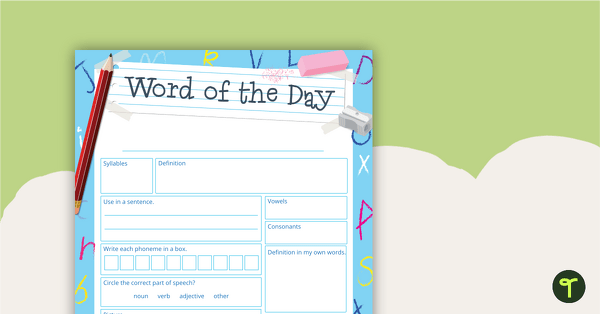
teaching resource
Word Of The Day Poster
A word of the day poster with a variety of tasks to give context and meaning to a word.
Show us Yours!
Do you have other awesome ideas for how to use word walls in your classroom? Share your ideas in the comment section of this blog.
Today’s classrooms contain more posted information than ever — learning goals, success criteria, classroom expectations, anchor charts, word walls… I could go on and on. Teachers are expected to cram more information to the same space year after year. How do you fit it all in?
Let’s talk about word walls. My word wall is one area that I personally felt was taking a TON of space, and I knew that I could use it more efficiently, so I’ve rounded up for you some examples of the best word walls and how you can make them work in ANY classroom!
The Traditional Word Wall
Large classroom or small, we’ve all seen the list of student names, common sight words, content vocabulary, and rule-breakers posted on a traditional word wall. When used correctly, they are an invaluable resource for our students in the primary grades and beyond.
Traditional word walls should be part of your word work instruction so that the students will actually refer to and use the words listed there. Words should be added gradually and with the help and input of your students. Words placed on the word wall should be part of your regular practice. Clapping, chanting, or guessing games like «Be a Mind Reader» or «Guess My Word» are fun ways for students to learn to read and recognize these words!
The Interactive Word Wall
Getting students physically involved with the word wall is a great way to help the learning «stick». Storing each word on a ring under the corresponding letter allows students to actually bring the word wall to them! Giving students hands-on word work activities to use with the word wall words is also a great way to help them quickly recognize and spell these words correctly.
I love this hands-on idea from Whimsy Workshop Teaching:
And my word work centers are a great way to get students’ hands on!
The Personal Word Book
Some classrooms simply don’t have the wall space for a large word wall. In cases like this, a personal word book or dictionary is a great way to give your students access to the words they need when reading and writing. You can make these resources interactive by giving students the space to add words of their own or use highlighters to direct their attention to certain words in the way you might color-code words on your wall. I personally LOVE using word books because I can more easily differentiate the words for my students’ varying needs!
The Word Family Wall
New to my classroom this year are word family lists! Closely linked to our word work lessons each week, these lists are space-saving and DIFFERENTIATED!!
Each week I introduce a word family or spelling pattern. We brainstorm words that have a particular pattern, look for additional words around the room or in our reading, then use them throughout the week during independent word work activities. What I love about this setup is that I can easily and discreetly differentiate by having my students working on different lists of words within each set.
The Rule Breaker Wall
Finally, some classrooms contain a special section of their word wall dedicated to the rule-breakers — those words that don’t follow the typical rules we teach kids about letter sounds and patterns. My coworker and friend, Christina, from Hanging Around In Primary, created this «Word Jail» that I absolutely love. She says, «I have the words in the Word Jail to help draw attention to them. We need students to learn these words by simple memorization. We spend a lot of time teaching decoding, but with Jail words, decoding is not helpful. By giving them their own special place you can easily practice them and draw students’ attention to them.» You can read more about Christina’s Word Jail HERE.
I hope that you’ve found some word wall inspiration in this post! If you have other tips for having a great word wall, please leave them in the comments. I love hearing from you!
You might also be interested in the tips and tricks for differentiating your word work that I’ve shared in this blog post:
The word wall letters in these headings can be found here:
Check out more word work ideas and resources on this Pinterest board:
Pin this post:

